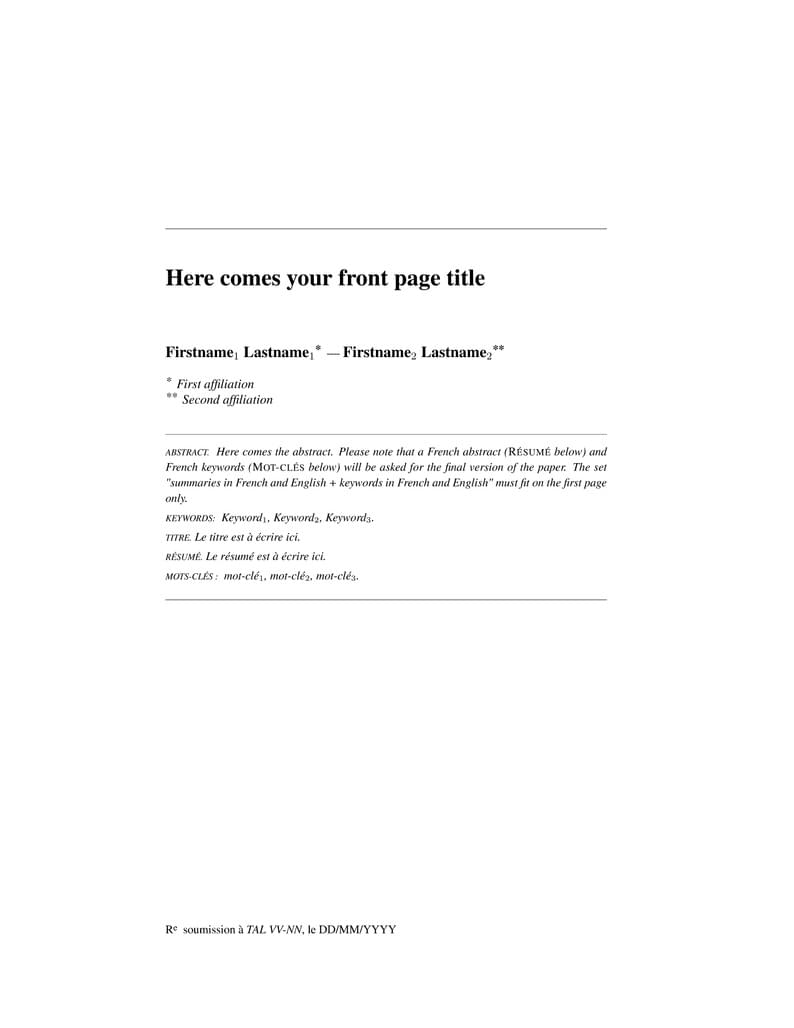
TAL Journal styles
Author:
Sophie Rosset
Last Updated:
2年前
License:
Creative Commons CC BY 4.0
Abstract:
TAL journal LaTeX style (https://www.atala.org/revuetal)

\begin
Discover why over 20 million people worldwide trust Overleaf with their work.
TAL journal LaTeX style (https://www.atala.org/revuetal)

\begin
Discover why over 20 million people worldwide trust Overleaf with their work.
\documentclass[english,utf8x]{article-hermes_frenchb}
% Created by Y. Lepage 08/10/2012
% Do not worry about the _french mention above. The style meets English standards
\usepackage[labelfont=bf,textfont=it,labelsep=period,justification=raggedright,singlelinecheck=false]{caption}
% Do not modify the line above
% Please fill in
% the date of your submission: DD/MM/YYYY
% the volume and number of the TAL issue you are submitting to: VV-NN
% whether this is the first submission (1) or a second submission after first review round (2): R
\submitted[DD/MM/YYYY]{TAL~VV-NN}{R}
% Two commands to be used only for the final version of accepted papers
% instead of the \submitted one
% \setcounter{page}{}
% Put the first page number between {}
% \journal{TAL. Volume VOL -- n°X/YYYY}{F}{L}
% VOL: TAL volume; X: TAL number in the volume; YYYY: year;
% F: first page number of the paper; L: last page number
\title[Short title]{Here comes your front page title}
\author{Firstname$_1$ Lastname$_1$\fup{*} \andauthor Firstname$_2$ Lastname$_2$\fup{**} }
\address{%
\fup{*} First affiliation\\
\fup{**} Second affiliation
}
\abstract{
Here comes the abstract.
Please note that a French abstract (\textsc{Résumé} below)
and French keywords (\textsc{Mot-clés} below)
will be asked for the final version of the paper. The set
"summaries in French and English + keywords
in French and English" must fit on the first page only.
}
\keywords{
Keyword$_1$,
Keyword$_2$,
Keyword$_3$.
}
\motscles{
mot-cl\'e$_1$,
mot-cl\'e$_2$,
mot-cl\'e$_3$.
}
\resume{Le titre est à écrire ici.}{Le r\'esum\'e est \`a \'ecrire ici.}
%\date{}
\begin{document}
\maketitlepage
%%%%%%%% FAKE TEXT %%%%%%%%%%%%%%%
\newcommand{\fakesentence}{Ensure that your figures and tables never go beyond the left and right margins. }
\newcommand{\fakeparagraph}{
\fakesentence
\fakesentence
\fakesentence
\fakesentence
\fakesentence
\fakesentence
}
%%%%%%%%%%%%%%%%%%%%%%%%%%%%%%
\section{Introduction}
When not specified,
latin1 is the encoding scheme by default.
For any other encoding scheme than latin1,
specify that encoding scheme as an option passed to
\verb$\documentclass$.
For instance:
\begin{quote}
\begin{verbatim}
\documentclass[english,utf8x]{article-hermes}
\end{verbatim}
\end{quote}
Possible encoding schemes are:
\texttt{latin1}, \texttt{latin9}, \texttt{utf8} or \texttt{utf8x}.
Your files, including the bibliography, should be in the specified encoding.
This template uses \texttt{utf8x}.
\fakeparagraph
\cite{Chmielik_TAL_52,Virpioja_TAL_52}
\section{A section of the paper}
\fakeparagraph
\cite{Celata_TAL_52}
\subsection{First sub-section}
\fakeparagraph
\cite{Walther_TAL_52}
\fakeparagraph
\cite{Lavallee_TAL_52}
\fakeparagraph
\subsection{Second sub-section}
\fakeparagraph
\fakeparagraph
\fakeparagraph
\subsection{Third sub-section}
\fakeparagraph
\fakeparagraph
\fakeparagraph
\section{Conclusion}
\fakeparagraph
\acknowledgements{The acknowledgments come here.}
\bibliography{TAL_biblio_ex}
\end{document}